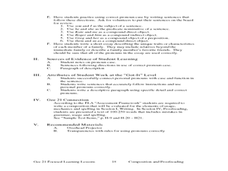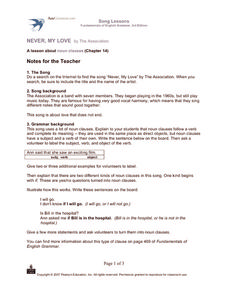Curated OER
Giving Oral Directions
Student practice giving directions. In this giving oral directions lesson plan, 2nd graders play Simon Says, identify differences between clear and unclear directions, and practice giving someone else directions in the room. Students use...
Curated OER
Night of the Twisters Figurative Language
In this reading worksheet, students read and learn about writers' use of figurative language to create vivid pictures with words. Students are directed to specific pages in The Night of the Twisters by Ivy Ruckman and answer 20 questions...
Curated OER
I Am, Am Not! Project
Get your class writing with this project idea. Kids choose two pictures of objects that are like them and two pictures of objects that are not like them to entice their readers. Then, they write an informative paragraph describing each...
Curated OER
Using Personal Pronouns Correctly
Complete personal pronoun practice activities. Pupils use correct personal pronoun form in sentences the teacher writes on the board. They review the function of a pronoun and the various cases and practice placing personal pronouns by...
Curated OER
Imagining China through Words
When Europeans first came back with tales of China, they provided vivid written accounts and minimal visual imput. This resulted in art rendered mostly from descriptive language. Learners explore this phenomena by listening to...
Curated OER
My Own Backyard
Students explore and react to the painting The Road to Santa Fe. In this interacting with art lesson, students locate various objects in the painting. Students copy the angle of objects by using their bodies. Students discuss...
University of Arizona
Fusing Firecrackers with Narrative
Improve your youngsters' descriptive writing. They study an object and write about what they see as a warm-up, then they read an excerpt from Paul Guest's memoir, One More Theory about Happiness. The next part of the...
Florida Center for Reading Research
Phonological Awareness: Phoneme Isolating, See It-Sound It
Working pairs, early readers put their hands into a mystery box, pull out an item, then name and identify its initial phoneme.
Curated OER
Lesson: Allison Smith: What Are You Fighting For?
Trench art is a nontraditional art form created by soldiers in trenches during wartime. Artist Allison Smith connects her art to the American Revolution and the question: "What are you fighting for?" Kids examine her art, how it connects...
Azar Grammar
Song Lessons: Never, My Love
Here's a clever way to introduce language learners to noun clauses. After a brief exercise that provides examples of different types of noun clauses, class members listen to the Association's "Never, My Love" and identify the clauses in...
Worksheet Web
Heteronyms
Challenge scholars to identify and use heteronyms in a sentence with a two-page worksheet designed to boost grammar skills.
Denver Art Museum
Alien Beauty
"Beauty is in the eye of the beholder," is a popular phrase in our society. The lesson here puts the phrase to the test as pupils explore what truly is beautiful through a study of some Japanese folk art. A careful examination of the...
Houghton Mifflin Harcourt
Surprise!: Extra Support Lessons (Theme 2)
Surprise! is the theme of a unit covering such topics as consonants, blending, short vowels sounds, high frequency words, and number words. The unit's lessons also include teachable moments covering story structure, illustrations,...
Tri-Valley Local Schools
Commonly Confused Words
Who gave you grammar homework? Or is it whom? Clarify the meanings of several commonly confused words, including affect and effect, among and between, and then and than with a handout and grammar practice learning...
K12 Reader
Why Does the Moon Orbit Earth?
Have you ever looked up at the moon and wondered why it looks different every night? Learn about the moon's orbit and the lunar cycle with a reading comprehension exercise. Using context clues, kids find the definitions of unfamiliar...
Reading Resource
Cars Puzzles (Basic Code Sentences)
Vroom vroom into reading skills! Bring a set of reading puzzles based on Disney's Cars to your special education or mainstream class. Each strip features a code sentence with the same vowel sound, and when kids put the strips...
Curated OER
Body Language
Students take pictures in different settings to demonstrate the importance and influence of body language. In this body language lesson plan, students use a camera and work in groups over a 5 week period.
Curated OER
Body Language? The Language of Contemporary Fashion
Young scholars examine the messages given to others based on their clothing. In groups, they compare and contrast the clothes of today with those from the 1980s. While being shown a picture of a piece of clothing, they practice object...
Curated OER
Giving Directions
First graders view the object on their desk observing the colors, patterns, and the way the object is put together but not touching it. They then write on paper the directions they would give someone so that they would be able to build...
Curated OER
The Gerund Phrase
Do your young grammarians need extra practice identifying gerund phrases? After reading a short definition and studying examples, learners underline the gerund phrases in 20 sentences. This worksheet could be used as the basis of a...
Curated OER
The Merchant of Venice Quiz
The Merchant of Venice is the focus of twenty multiple-choice and fill-in-the-blank questions in this quiz that begins by focusing on characters. Quotes and specific objects in the play factor in to later questions.
Curated OER
Finish the Picture
Explore positional prepositions as learners follow directions by adding four details to this picture of a fairy. Each instruction includes both an object and its location, so scholars get plenty of review. Consider also allowing them to...
Curated OER
It's Between!
Pre-readers follow directions to better understand relative position and the preposition between. They draw a ball between four sets of objects, then a shape between two sets of shapes. Tip: Have little ones line up, then move them...
Curated OER
Direct Express
Although the game cards are not posted at this time, you could easily create some to put this plan into action. Simply write a few starting lines from different speeches on each index card, and have learners guess if the speaker's intent...























